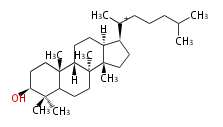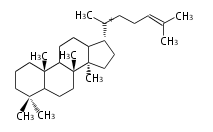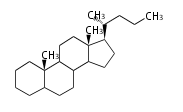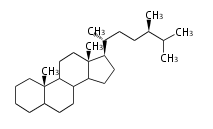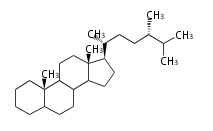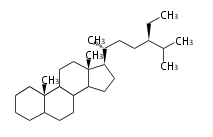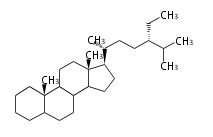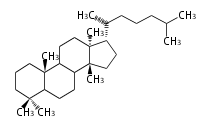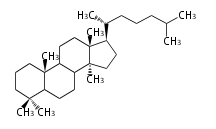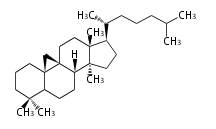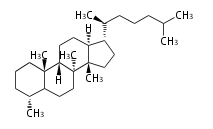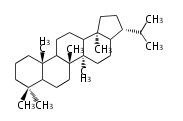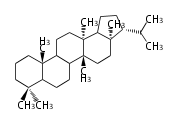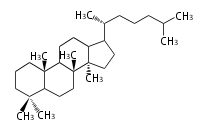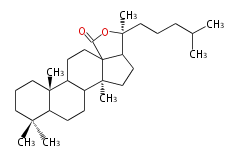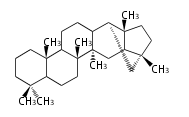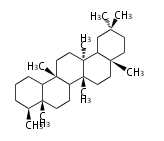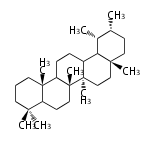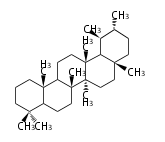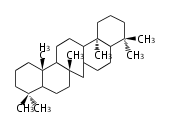Category:TP3
m (→Biosynthesis) |
(→Biosynthesis) |
||
| Line 67: | Line 67: | ||
<center> | <center> | ||
{|style="text-align:center" | {|style="text-align:center" | ||
| − | |||
| − | |||
|style="background-color:#fdd"| ANIMALS, FUNGI, and YEAST | |style="background-color:#fdd"| ANIMALS, FUNGI, and YEAST | ||
|style="background-color:#dfd"| PLANTS | |style="background-color:#dfd"| PLANTS | ||
|- | |- | ||
| − | |||
| − | |||
|colspan="2"| 2,3-oxidosqualene | |colspan="2"| 2,3-oxidosqualene | ||
|- | |- | ||
| − | |||
| − | |||
|colspan="2"|[[Image:2,3-oxidosqualene.png]] | |colspan="2"|[[Image:2,3-oxidosqualene.png]] | ||
|- | |- | ||
| − | |||
| − | |||
| lanosterol [[Image:Arrow00dl35.png]] synthase<ref>The most accessible enzyme among oxidosqualene cyclases.<br/>''Ref.'' Corey EJ, Russey WE, Ortiz-de-Montellano PR (1966) 2,3-Oxidosqualene, an intermediate in the biological synthesis of sterols from squalene ''J Am Chem Soc'' 88:4750-1</ref> | | lanosterol [[Image:Arrow00dl35.png]] synthase<ref>The most accessible enzyme among oxidosqualene cyclases.<br/>''Ref.'' Corey EJ, Russey WE, Ortiz-de-Montellano PR (1966) 2,3-Oxidosqualene, an intermediate in the biological synthesis of sterols from squalene ''J Am Chem Soc'' 88:4750-1</ref> | ||
| lupeol [[Image:Arrow00dr35.png]] synthase | | lupeol [[Image:Arrow00dr35.png]] synthase | ||
|- | |- | ||
| − | |||
| − | |||
| − | |||
| − | |||
| 17β-protosteryl cation<ref>The rings of protosteryl cation are chair-boat-chair configuration. The C-17 chain is β-configuration, not α.<br/> | | 17β-protosteryl cation<ref>The rings of protosteryl cation are chair-boat-chair configuration. The C-17 chain is β-configuration, not α.<br/> | ||
''Ref.'' Corey EJ, Virgil SC (1991) An experimental demonstration of the stereochemistry of enzymic cyclization of 2,3-oxidosqualene to the protosterol system, forerunner of lanosterol and cholesterol. [http://pubs.acs.org/doi/abs/10.1021/ja00010a073 ''J Am Chem Soc'' 113:4025-6]</ref> | ''Ref.'' Corey EJ, Virgil SC (1991) An experimental demonstration of the stereochemistry of enzymic cyclization of 2,3-oxidosqualene to the protosterol system, forerunner of lanosterol and cholesterol. [http://pubs.acs.org/doi/abs/10.1021/ja00010a073 ''J Am Chem Soc'' 113:4025-6]</ref> | ||
| Line 96: | Line 84: | ||
<br/>[[Image:Dammarenyl cation.png]] | <br/>[[Image:Dammarenyl cation.png]] | ||
|- | |- | ||
| − | | | + | |align="center"| |
| − | | | + | {| |
| − | + | |- valign="top" | |
| + | | 1,2-[[Image:Arrow00d.png]] shift | ||
| + | | [[Image:Arrow00dr35.png]] | ||
| + | | protostane | ||
| + | |} | ||
| D-ring [[Image:Arrow00d35.png]] expansion | | D-ring [[Image:Arrow00d35.png]] expansion | ||
|- | |- | ||
| − | |||
| − | |||
| lanosteryl cation<br/>[[Image:Lanosteryl cation.png]] | | lanosteryl cation<br/>[[Image:Lanosteryl cation.png]] | ||
| baccarenyl cation<br/>[[Image:Baccarenyl cation.png]] | | baccarenyl cation<br/>[[Image:Baccarenyl cation.png]] | ||
|- | |- | ||
| − | | [[Image: | + | |align="center"| |
| − | + | {| | |
| − | | [[Image: | + | |- valign="top" |
| + | | 1,2-[[Image:Arrow00d.png]] shift | ||
| + | | [[Image:Arrow00dr35.png]] | ||
| + | |style="background-color:#fdd"| lanostane<br/>cycloartane<br/>all steroids | ||
| + | |} | ||
| [[Image:Arrow00d35.png]] | | [[Image:Arrow00d35.png]] | ||
|- | |- | ||
| − | | | + | | cucurbitenyl cation<br/>[[Image:Cucurbitenyl cation.png]] |
| − | + | ||
| − | + | ||
|style="background-color:#dfd"| lupeol<br/>[[Image:Lupeol.png]] | |style="background-color:#dfd"| lupeol<br/>[[Image:Lupeol.png]] | ||
|- | |- | ||
| − | |||
| − | |||
|style="background-color:#fdd"| Examples.<br/>All steroids including steroidal saponins | |style="background-color:#fdd"| Examples.<br/>All steroids including steroidal saponins | ||
|style="background-color:#dfd"| Examples.<br/>all triterpenoids and saponins | |style="background-color:#dfd"| Examples.<br/>all triterpenoids and saponins | ||
| Line 128: | Line 118: | ||
Useful Reviews: | Useful Reviews: | ||
* Xu R, Fazio GC, Matsuda SPT (2004) On the origins of triterpenoid skeletal diversity. ''Phytochemstry'' 65:261-291 PMID 14751299 | * Xu R, Fazio GC, Matsuda SPT (2004) On the origins of triterpenoid skeletal diversity. ''Phytochemstry'' 65:261-291 PMID 14751299 | ||
| + | |||
| + | {| style="text-align:center" | ||
| + | |- | ||
| + | |style="background-color:#ddf"| BACTERIA | ||
| + | | | ||
| + | |- | ||
| + | | squalene | ||
| + | | | ||
| + | |- | ||
| + | | [[Image:squalene.png]] | ||
| + | | [[Image:Arrow00r.png]] | ||
| + | |- | ||
| + | | squalene-hopene [[Image:Arrow00d35.png]] cyclase<ref>The most accessible enzyme among squalene cyclases. <br/>''Ref.'' Kannenberg EL, Poralla K (1999) Hopanoid biosyntehsis and function in bacteria. ''Naturwissenschaften'' 86:168-76.<br/>The cyclization process is stepwise, not concerted as previously thought. As one clue, squalene is not fully folded in the cyclase active site.<br/>''Ref.'' Reinert DJ, Balliano G, Schulz GE (2004) Conversion of squalene to the pentacarbocyclic hopene. ''Chem Biol'' 11:121-6</ref> | ||
| + | | | ||
| + | |- | ||
| + | | 17α-deoxydammarenyl cation<ref>The C-17 chain of deoxydammarenyl cation is α-configuration.<br/> | ||
| + | ''Ref.'' Wendt KU, Schulz GE, Corey EJ, Liu DR (2000) Enzyme mechanisms for polycyclic triterpene formation. [http://www3.interscience.wiley.com/journal/72515653/abstract?CRETRY=1&SRETRY=0 ''Angew Chem, Int Ed'' 39:2812-33]</ref> | ||
| + | <br/>[[Image:Deoxydammarenyl cation.png]] | ||
| + | | | ||
| + | |- | ||
| + | | D-ring [[Image:Arrow00d35.png]] expansion<ref>Ring C is also expanded from its 5-membered precursor.</ref> | ||
| + | | | ||
| + | |- | ||
| + | |[[Image:Hopyl cation.png]] | ||
| + | | | ||
| + | |- | ||
| + | | [[Image:Arrow00d35.png]] | ||
| + | | | ||
| + | |- | ||
| + | |style="background-color:#ddf"| hopene<br/>[[Image:Hopene.png]] | ||
| + | | | ||
| + | |- | ||
| + | |style="background-color:#ddf; vertical-align:top" | Examples. | ||
| + | | | ||
| + | |} | ||
==Design of Tri-terpene ID numbers ID番号の設計== | ==Design of Tri-terpene ID numbers ID番号の設計== | ||
Revision as of 01:58, 9 August 2010
Contents |
Triterpene (C30) Classes
Ring configuration
The basic structure is 4 carbon rings, cyclopenta[a]phenanthrene, gonane, or sterane. The rings B/C are always trans in all natural steroids. If the rings C/D are trans, it is called gonane. If its stereochemistry is unspecified, it is called sterane. Most steroids take gonane form, but in cardenolides and bufanolides, the rings C/D are cis.
 |

|
| Cyclopenta[a]phenanthrene | Gonane |
The majority of steroids have methyl groups sticking out from the bridgehead positions C-10 and C-13. When these methyl groups (or hydrogens) stand above the plane, they are called β-configuration. Those below the plane are called α-configuration. If the configuration at any site is unknown, it is indicated as ξ (Greek Xi). By default, hydrogen atoms or substituents at the positions C-8, 9, 10, 13, and 14 are assumed to be 8β, 9α, 10β, 13β, and 14α configurations. C-5 is a special position, because there are as many 5α steroids as 5β are.
 |
 |

|
| cholestane backbone | 5α-configuration | 5β-configuration |
Biosynthesis
The starting point is squalene, which is formed by joining two FPPs tail-to-tail. Bacterial cyclases use squalene directly, but those of the other species use 2,3-oxidosqualene for cyclization.
- In bacteria, squalene is cyclized via the 17α-deoxydammarenyl cation to hopene and other triterpenes[1].
- In eukaryotes, 2,3-oxidosqualene is cyclized via the protosteryl cation to lanosterol (animals and fungi) or cycloartenol (plants) by a series of 1,2-hydride and methyl shifts (Wagner-Meerwein shifts).[2]
- In plants, various triterpenes arise from the dammarenyl cation.
| ANIMALS, FUNGI, and YEAST | PLANTS | |||
| 2,3-oxidosqualene | ||||
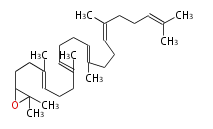
| ||||
| lanosterol |
lupeol | |||
| 17β-protosteryl cation[4] | 17β-dammarenyl cation[5] | |||
|
D-ring | |||
lanosteryl cation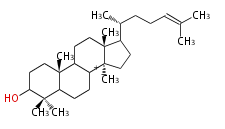
|
baccarenyl cation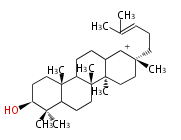
| |||
|
| |||
cucurbitenyl cation
|
lupeol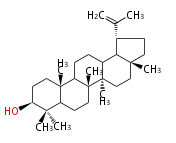
| |||
| Examples. All steroids including steroidal saponins |
Examples. all triterpenoids and saponins | |||
- ↑ Bacterial squalene cyclases can accept oxidosqualene as their substrates, but oxidosqualene usually does not exist in bacteria
- ↑ A trace amount of phytosterols comes from lanosterol. Ohyama K, Suzuki M, Kikuchi J, Saito K, Muranaka T (2009) Dual biosynthetic pathways to phytosterol via cycloartenol and lanosterol in Arabidopsis Proc Natl Acad Sci USA 106(3):725-730
- ↑ The most accessible enzyme among oxidosqualene cyclases.
Ref. Corey EJ, Russey WE, Ortiz-de-Montellano PR (1966) 2,3-Oxidosqualene, an intermediate in the biological synthesis of sterols from squalene J Am Chem Soc 88:4750-1 - ↑ The rings of protosteryl cation are chair-boat-chair configuration. The C-17 chain is β-configuration, not α.
Ref. Corey EJ, Virgil SC (1991) An experimental demonstration of the stereochemistry of enzymic cyclization of 2,3-oxidosqualene to the protosterol system, forerunner of lanosterol and cholesterol. J Am Chem Soc 113:4025-6 - ↑ The rings of dammarenyl cation are all-chair configuration. The C-17 chain is β-configuration.
Ref. Xiong Q, Rocco F, Wilson WK, Xu R, Ceruti M, Matsuda SPT (2005) Structure and reactivity of the dammarenyl cation: configuration transmission in triterpene synthesis. J Org. Chem. 70:5362-75
Useful Reviews:
- Xu R, Fazio GC, Matsuda SPT (2004) On the origins of triterpenoid skeletal diversity. Phytochemstry 65:261-291 PMID 14751299
| BACTERIA | |
| squalene | |
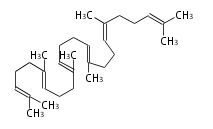
|
|
| squalene-hopene |
|
| 17α-deoxydammarenyl cation[2] | |
| D-ring |
|
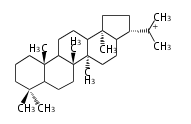
|
|
| |
|
hopene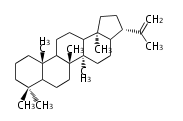
|
|
| Examples. |
Design of Tri-terpene ID numbers ID番号の設計
12-DIGIT
| T | P | 3 | x | y | y | r | h | g | n | c | c |
- x ... species information
| Symbol at x | Kingdom | Phyla | Examples |
|---|---|---|---|
| I | Animalia | Arthropoda (Insects, crabs) | ecdysteroids |
| V | Chordate (Vertebrates) | sex steroids, corticosteroids, anabolic steroids | |
| O | Others | marine steroids | |
| P | Plantae | Phytosterols | lanosterols, cholesterols, brassinolides |
| S | Saponins | saponins | |
| F | Fungi | ergosterols | ergosterols |
| B | Bacteria | bacterial sterols | hopanoids |
- y ... backbone structure (母核構造)
- r ... number of major rings (環構造数)
Click above categories to see details.
- h ... hydroxylation pattern (水酸基数)
Click above categories to see details.
- g ... glycosylation pattern(糖修飾パターン)
Click above categories to see details.
- n ... number of sugars (修飾糖数)
Click above categories to see details.
- c ... serial number (通し番号)
Cite error:
<ref> tags exist, but no <references/> tag was found
This category currently contains no pages or media.
